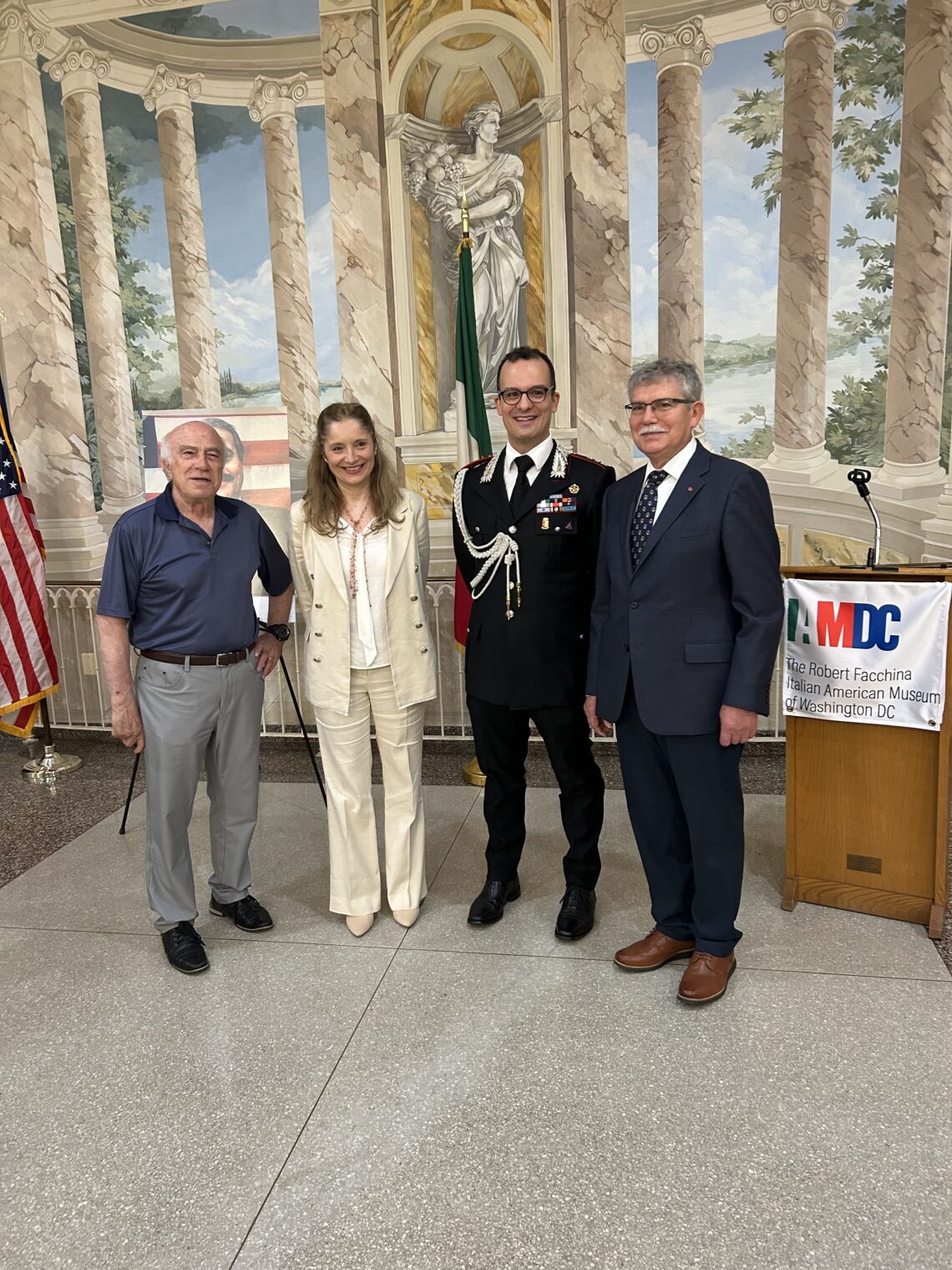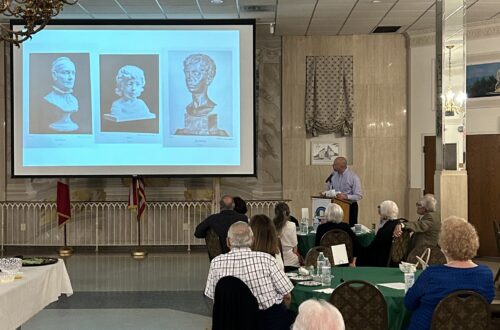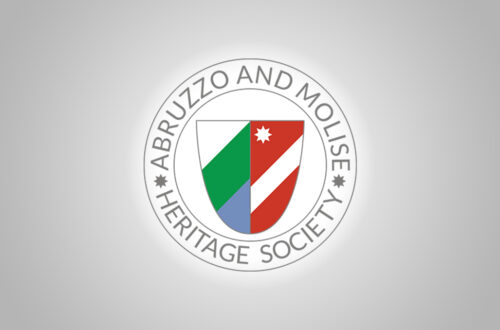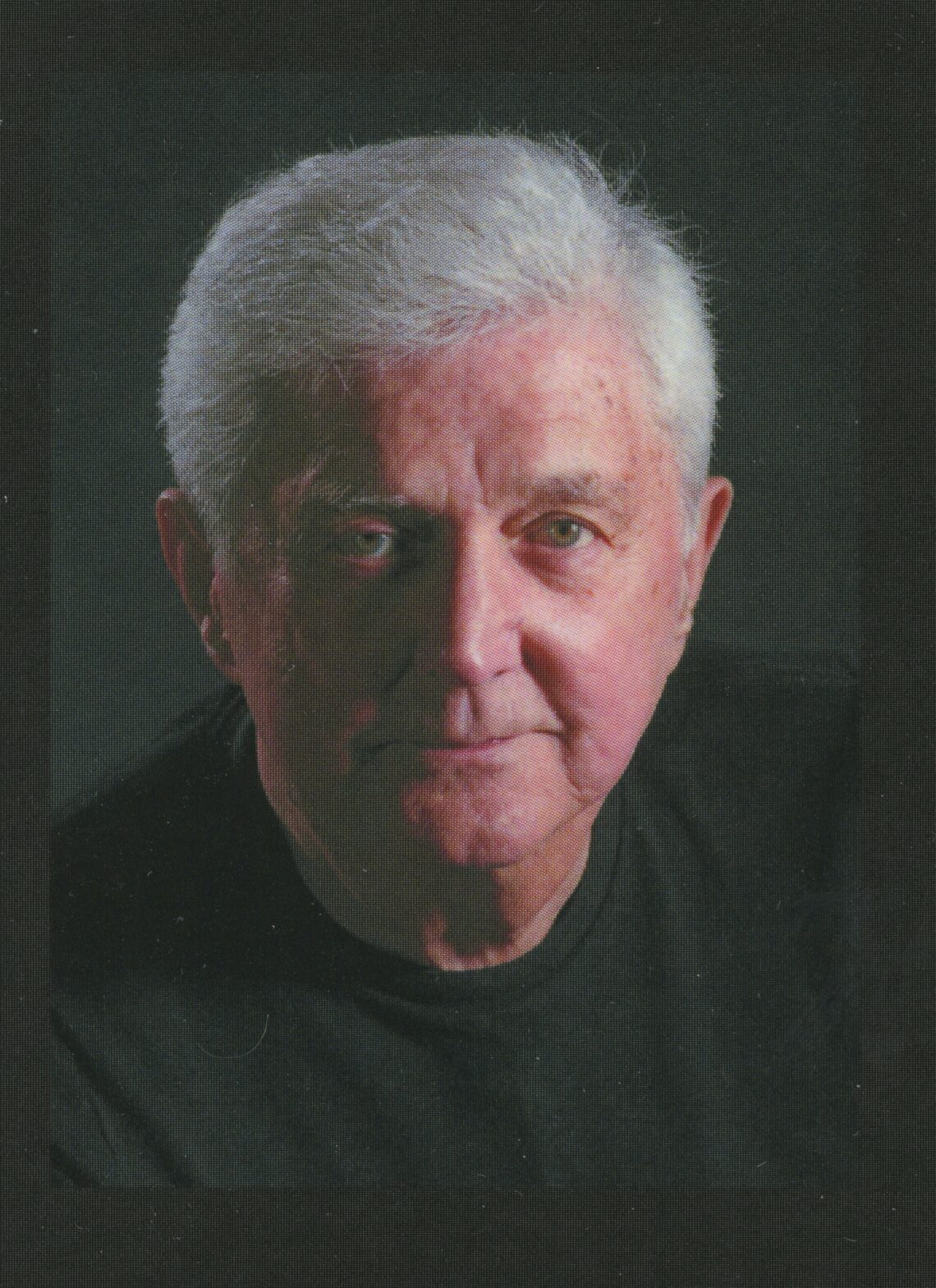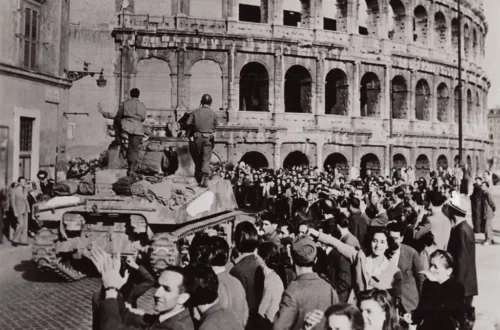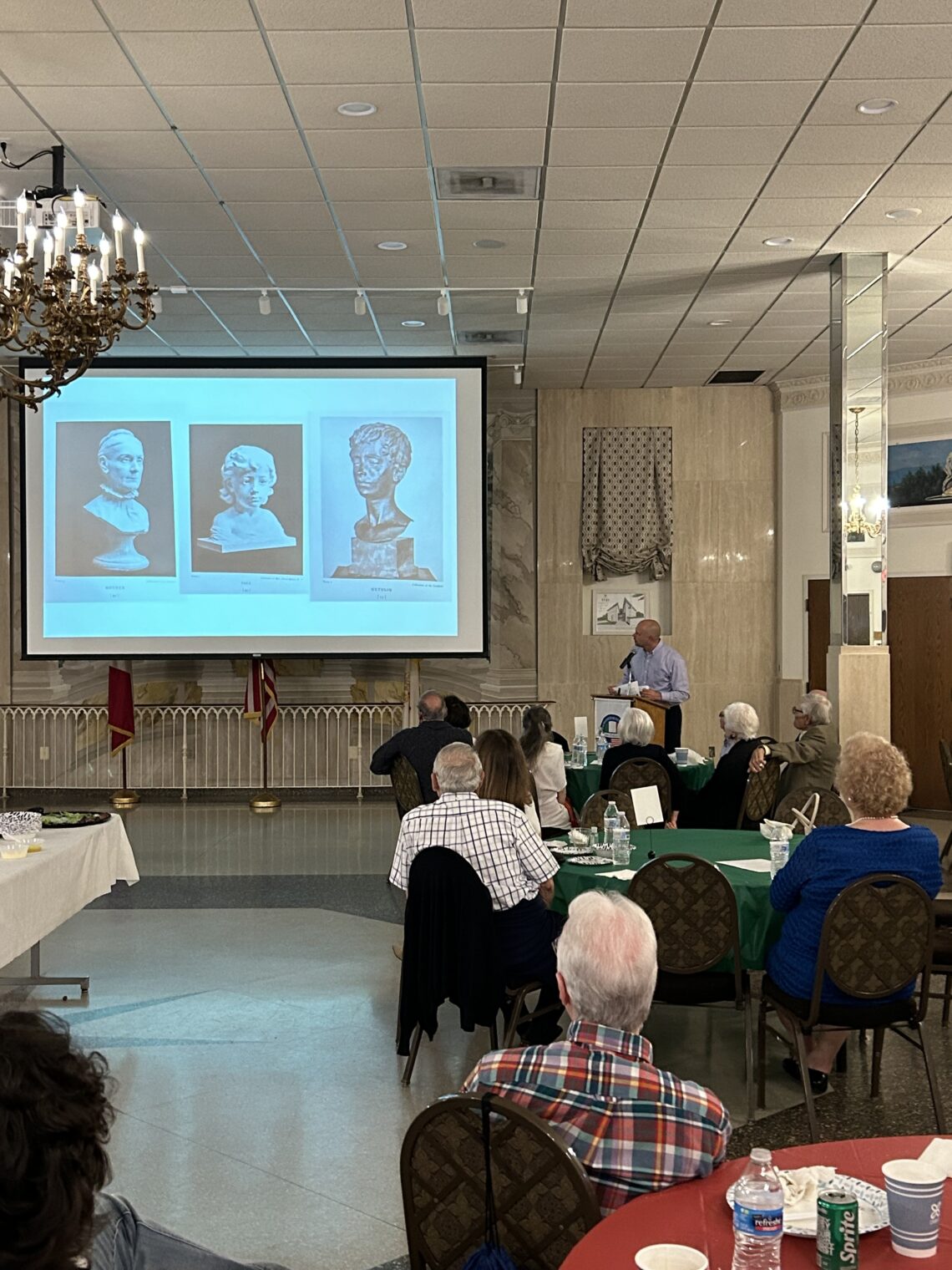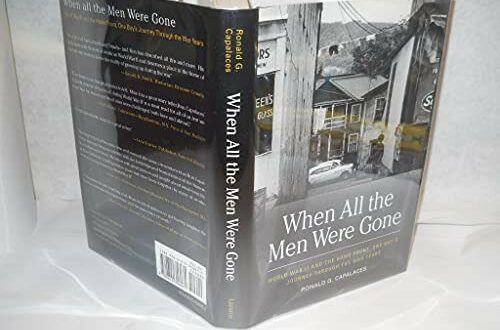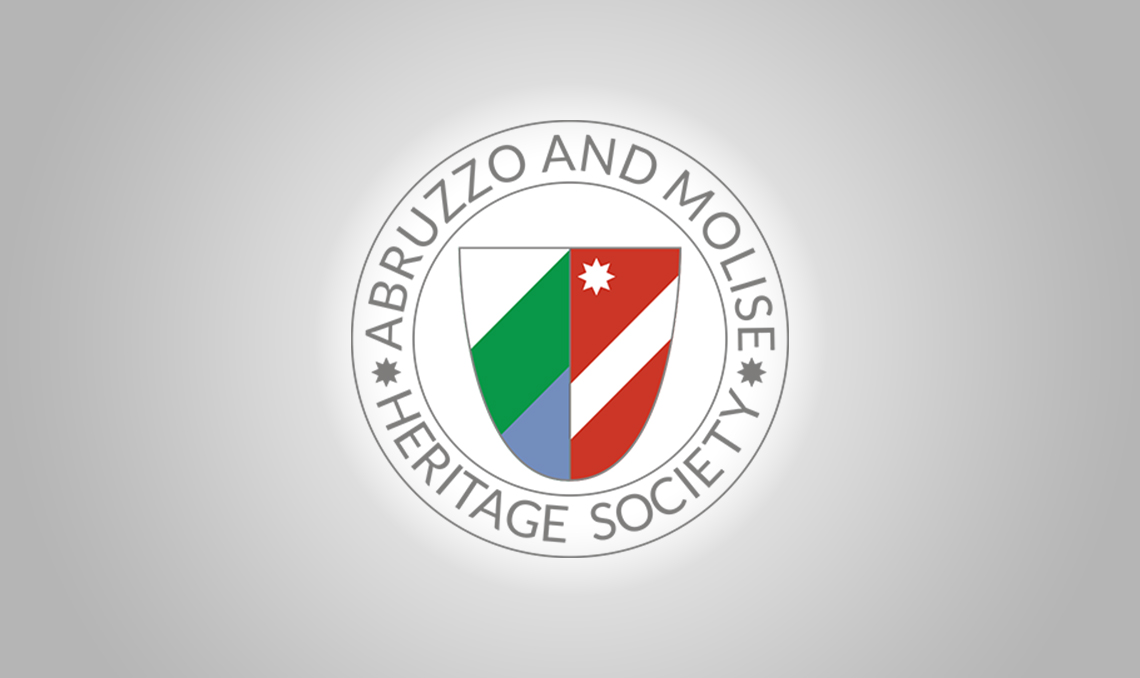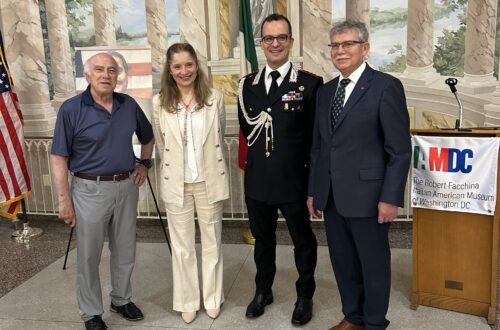-
Giovanni Falcone Remembered at Casa Italiana Ceremony
By Nancy DeSanti
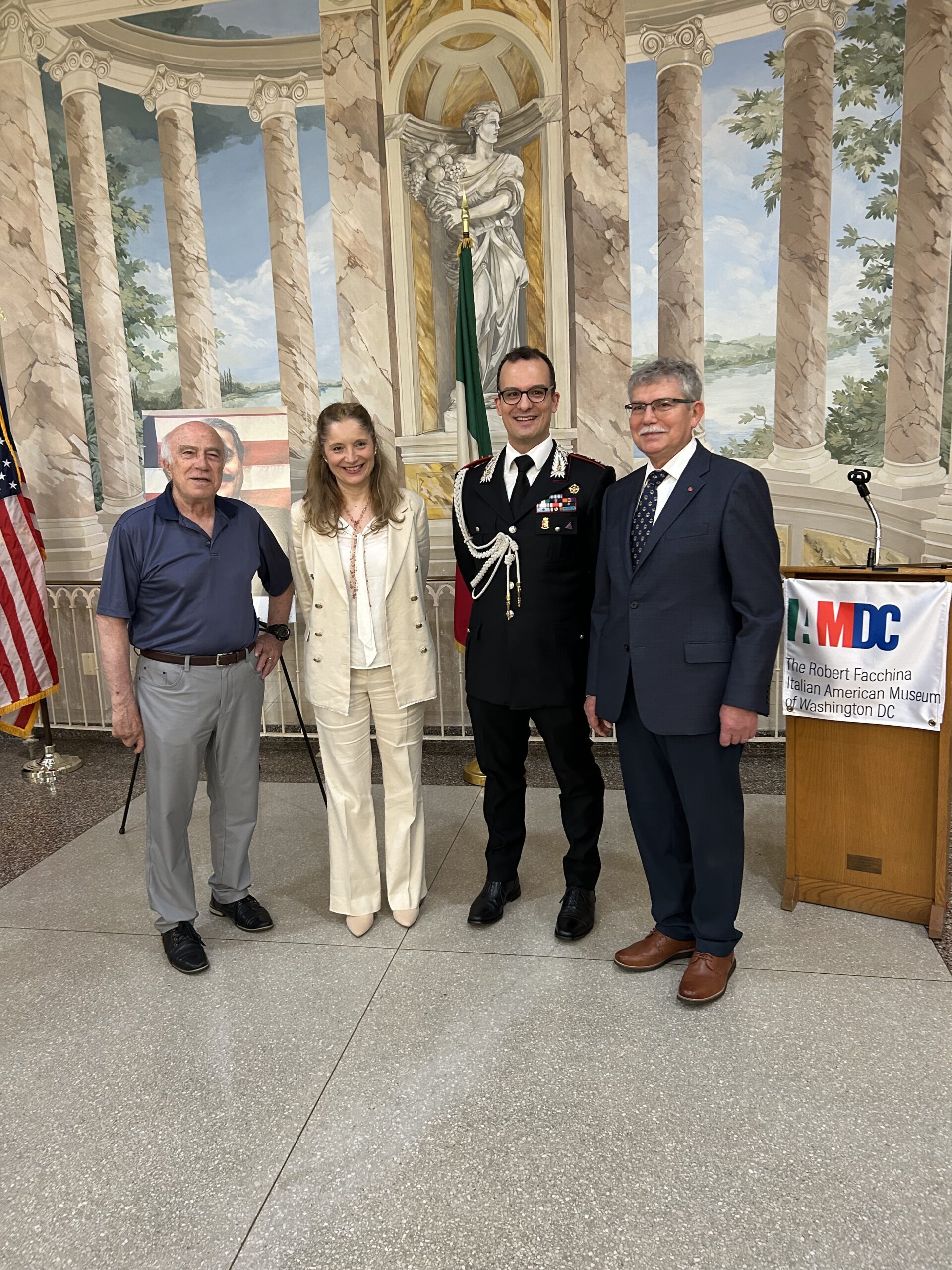
Pictured at the reception following the Mass in memory of the 32nd anniversary of the murder of Giovanni Falcone are (left to right) AMHS members and former president Ennio Di Tullio; Michela Carboniero, the First Counselor of the Embassy of Italy; Col. Pierangelo Iannicca, Assistant Defense Attache representing the Carabinieri), and Francesco Isgro, AMHS member and President of the Italian Sociocultural Center.
Credit: Nancy DeSantiThe 32nd anniversary of the assassination of anti-Mafia Judge Giovanni Falcone was commemorated in a civil ceremony inside Casa Italiana on Sunday, May 26, 2024. The ceremony was preceded in the Holy Rosary Church by a Mass attended by representatives of the Embassy of Italy. The event was organized by AMHS member, Francesco Isgro, who is also the president of the Casa Italiana Sociocultural Center. The event was co-sponsored by several Italian-American organizations, including AMHS.
Falcone was assassinated by members of the Sicilian Mafia on May 23, 1992, after leaving the airport in Palermo, Sicily, as he headed towards the city of Palermo. A huge bomb was detonated, killing Falcone, his wife, and their bodyguards. A memorial along the road to Capaci marks the spot where the explosion took place. Not long afterwards, his colleague Paolo Borsellino was also assassinated. Shortly thereafter, the Palermo airport was renamed the Falcone-Borsellino Airport.
The First Counselor of the Italian Embassy, Michela Carboniero, gave the opening remarks. She noted that, whenever she vacations in Sicily, as she passes the Capaci memorial on the road from the airport, she makes sure to point it out to her daughter so she will remember the event too.
The guest speaker was Lt. Col. Peirangelo Iannicca of the Carabinieri Corps. He is the Assistant Defense Attache for the Embassy of Italy. He gave an impassioned speech on the meaning of duty, honor, and courage, and he quoted some of Falcone’s famous sayings. After his speech, his son came running up to him, saying “bravo, papa!” In speaking with him later, AMHS member Elisa DiClemente learned that Col. Iannicca is Abruzzese.
After the remarks, everyone was invited to the reception, organized by Simonetta Baldassari, who decorated the Casa Italiana beautifully. As a finishing touch, each attendee was given a long-stemmed red rose.June 2024
-
Author Ronald G. Capalaces Will Address AMHS on WWII Era Memories
By Joseph “Sonny” Scafetta, Jr.
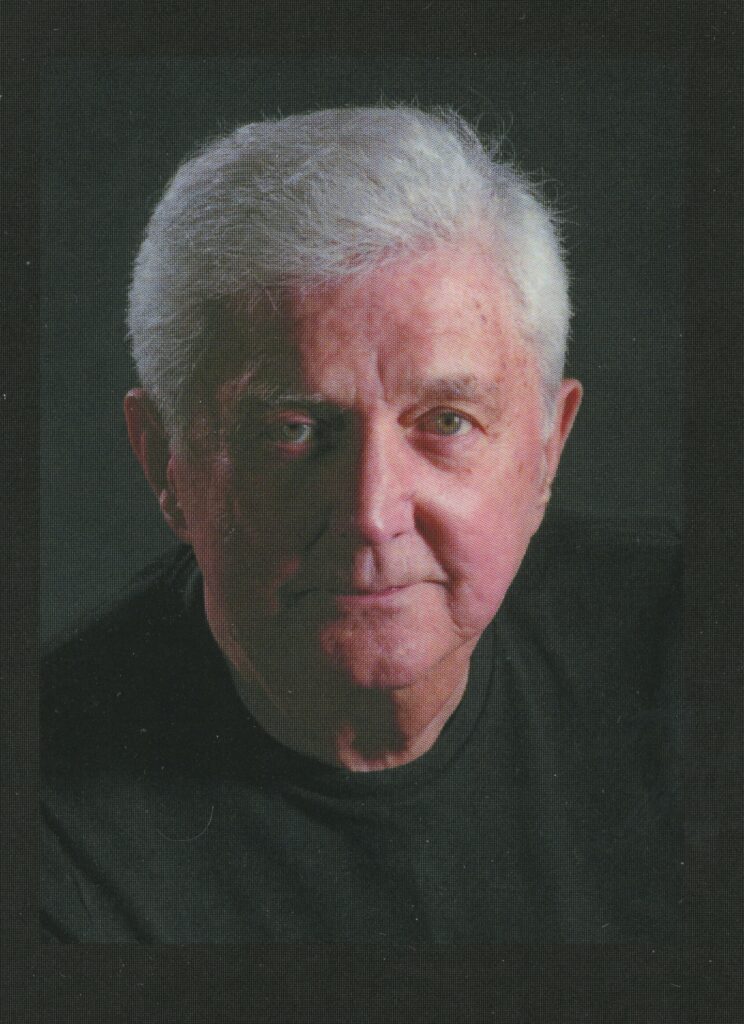
Author and Speaker Ronald G. Capalaces
Credit: Courtesy of Ronald CapalacesRonald G. Capalaces will be the guest speaker for our luncheon on Sunday, July 14, 2024, at 1:30 p.m., in the Pines of Florence Italian Restaurant, 1990 M St., N.W., Washington. Mr. Capalaces is the author of “When All the Men Were Gone,” a memoir about his boyhood growing up on the home front during World War II.
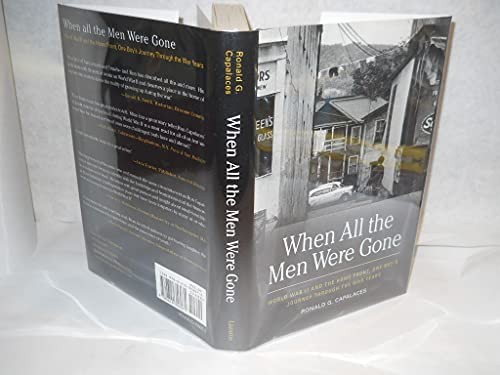
Ron was born in Binghamton, New York. During World War II, Ron’s father was a U.S. army soldier fighting in North Africa. His father was killed in combat there in 1943, when Ron was eight years old. After graduating from the local high school, Ron attended Harper College in Binghamton, now a campus of the State University of New York (SUNY). He later married Marie with whom he has five daughters. Ron’s career involved producing TV and film productions for clients. Ron retired in 2000. He and his wife now reside in McLean, Virginia.
Ron will read three short chapters from his 252-page book about his boyhood for about a half hour. He will start by reading the prologue about the differences between the 1940s and the 2010s. He will next read a humorous chapter about an encounter between him, a live chicken, and his mother. He will conclude by reading a chapter about the day that he learned that his father had died. A question-and-answer period will follow. Copies of Ron’s book will be available for sale to interested attendees for $16 each. Amazon lists the book for sale online for $30. Ron will autograph your copy upon request, at no extra charge.
Seating is limited to 44. For information on reservations and menu selections, please click HERE.June 2024
-
How Six Immigrant Brothers Left Their Mark On American Cities
By Nancy DeSanti, 1st Vice President—Programs
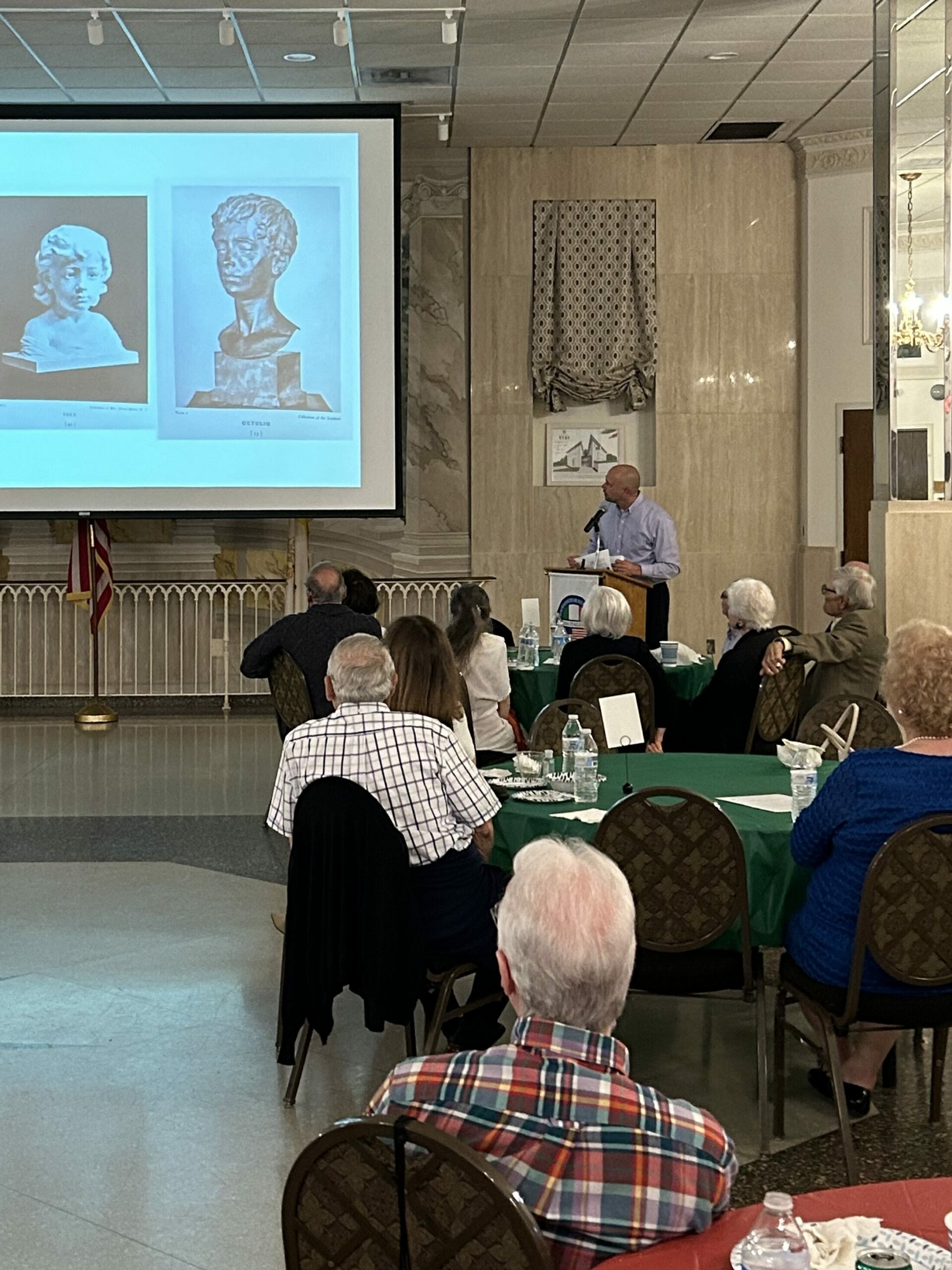
John Belardo (at lectern) gave a presentation on the work of the Piccirilli brothers to assembled AMHS members and guests on May 19.
Credit: Carmine James Spellane
Most Americans are not aware of the many masterpieces of the Piccirilli brothers, but AMHS members and guests at a recent program at Casa Italiana had the opportunity to learn a great deal about them from John Belardo, an accomplished sculptor from New York City. Belardo is an expert on the six famous Italian immigrant brothers who had a hand in some of the most important and famous sculptures we have both in Washington, D.C., and in New York City.
The AMHS program on Sunday, May 19, 2024, was co-sponsored by the Casa Italiana Sociocultural Center. Among the attendees were Steven Livengood, the Public Historian for the U.S. Capitol Historical Society, and Davide Prete, an Italian sculptor from Treviso, now living in Washington. He donated two of his works to the Italian-American Museum of Washington, D.C.
Belardo became interested in the marble carvings and sculptures of the Piccirilli brothers while he was a teacher in the Bronx, not too far from the building where the brothers set up their studio after emigrating from the Tuscan province of Massa-Carrara in 1888, first settling in Manhattan. They ended up in the Bronx, about 20 blocks from where Yankee Stadium is now located, after their mother became ill and the doctor advised her to “move to the country.” It is hard for us today to imagine that back then the Bronx was considered the country!
Belardo was educated as a sculptor at the New York Academy of Art and has been a visiting scholar for the Institute for American Universities. His work is wide ranging, from monumental public installations to digital prototypes and designs, as well as large-scale ceramic sculptures. He was recently the Artist in Residence at Chesterwood, which is the historic home of Daniel Chester French, the designer of the Lincoln Memorial. Belardo’s work is permanently installed at Georgetown University, Cooperstown N.Y., and Lehman College CUNY, where he currently teaches. He recently presented a talk, “Piccirilli Studio,” at the annual conference of the National Sculpture Society.
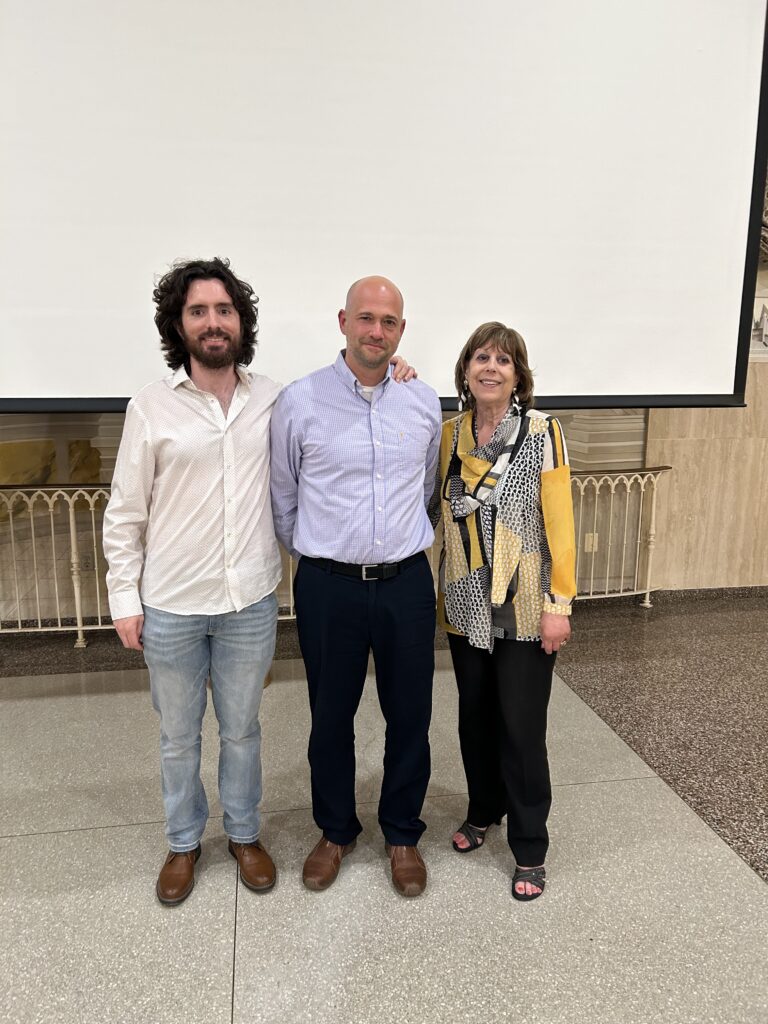
John Belardo (center) received thanks fro his presentation from AMHS President Chris Renneker (left) and First Vice President-Programs Nancy DeSanti. (Credit: Carmine James Spellane) According to Belardo, among the six talented Piccirilli brothers—Ferruccio, Attilio, Furio, Masaniello, Orazio, and Getulio–the most accomplished was Attilio. The brothers learned from their father Giuseppe, who himself came from a long line of stone carvers. While the brothers were known primarily as architectural modelers and carvers of other sculptors’ works, Attilio and Furio further distinguished themselves as sculptors in their own right.
Belardo noted that the brothers were known for treating their workers well, and at one point their workers numbered up to 100.
Not surprisingly, the brothers’ talent was quickly recognized, and artists from all over the country came to their studio. At that time, most prominent sculptors created their original work in clay. From that clay model, a caster generated a plaster model. The plaster model was then sent to the Piccirilli brothers who carved it in stone, usually marble. As Belardo pointed out, if you make a mistake working with clay, it can be fixed, but not so with stone and marble. Soon, well-known designers, such as Daniel Chester French, called on the brothers to help to execute the “city beautiful” idea of transforming American cities to look like the grand cities of Europe.
The Piccirillis did much to beautify New York City, including the original pediment of the New York Stock Exchange, and their carvings are exhibited in the atrium of the Metropolitan Museum of Art. Perhaps their best-known works there are the magnificent lions flanking the entrance to the New York City Public Library.
In Washington, their best-known work is the colossal Lincoln statue which was designed by Daniel Chester French and unveiled in 1922. The 28 separate blocks were shipped from their Bronx studio and put together here inside the Lincoln Memorial.
Another one of their projects in Washington was the beautiful DuPont Circle fountain, which has three allegorical figures representing modes of navigation by the sea, the stars, and the wind. The figures are very fitting, since the fountain is named after Rear Admiral Samuel DuPont.
The last of Attilio’s public commissions was the Guglielmo Marconi statue located outside a public library at 16th & Lamont Streets, N.W., in the Mount Pleasant neighborhood of D.C. It was dedicated in 1941. The sculpture features two bronze pieces. In the front, there is a bust of Marconi while the second bronze is an allegorical female figure sitting on a globe. It is a fine tribute to the great inventor whose 150th birthday anniversary is being celebrated this year.
Belardo summarized the Piccirilli style as embodying simplicity, beauty, and elegance. To pass on their knowledge, Attilio established the Leonardo da Vinci Art School for impoverished, mostly immigrant students who could not afford regular tuition and who attended school mostly at night, after work. Unfortunately, the school closed during World War II. Not long afterwards, a fire damaged the studio, including their historical records.
Washington, D.C., and New York City owe a debt of gratitude for the legacy which the brothers left in the cities that they beautified.
Our sincerest thanks to our speaker John Belardo for making the trip from New York City with his son Joseph at their own expense. Also, many thanks to Peter Bell for delivering the delicious lunch from A. Litteri’s, and to those members who donated raffle prizes and bought tickets.
June 2024
-
AMHS Membership
By Rico Allegrino, 2nd Vice President-Membership
New Members Welcome to our New Members:
Maxwell Tomashek, Dayna Cavanaugh,Daniela Di Tullio, Mark Evans, Julie Klosky, and Frank Di PieroBirthdays Compleanni a Maggio
Michael Iademarco, May 1; Joseph Scafetta Jr., May 10; Amy Antonelli, May 15; Kathlyn Nudi, May 16; Victor Ferrante, May 16; Robert Woolley, May 19; Peter Bell, May 20; Giulia Michonski, May 21; Aldo D’Ottavio, May 22; Cora Williams, May 22; John Dunkle, May 25; Richard Leibold, May 29; Ennio DiTullio, May 29; Renato Orcino, May 30Compleanni a Giugno
Rev. Frank Donio, June 3; Jo-Ann Pilardi, June 9; Alberto L. Paolantonio, June 10; Tony Andreoli, June 16; Tania Colavita Callas, June 18; Joan Galles, June 24; Helen Antonelli Free, June 30; Laura Gentile, June 30Compleanni a Luglio
Julia Paola, July 5; Dianne Francesconi Lyon, July 6; Daniel Piazza, July 11; Raymond Bernero, July 12; David Ciummo, July 13; Teresa Black, July 13; Anthony D’Onofrio, July 15; Roberto Severino, July 19; Mary Smargiassi Muth, July 22; Lina Pronio, July 23; and Lynn Sorbara, July 27Anniversaries Anniversari a Maggio
Rev. John DiBacco, May 13 (ordination); Barry & Midge Shawley, May 17; Francesco & Anna Isgro, May 19; Carmine Spellane & Ruth Bergman, May 29Anniversari a Giugno
Omero & Belinda Sabatini, June 6; Jeff & Macarena Clark, June 16; Lucio & Edvige D’Andrea, June 27Anniversari a Luglio
Joseph & Joann Novello, and Joseph “Sonny” & Teresa Scafetta, July 4; Berardino Palazzo & Ilaria Pirocchi, July 10; Robert & Barbara Verdile, July 17; Renato & Rita Orcino, July 19; Greg & Diane Bernabei, July 21; Daniel & Jill Piazza, July 22; Brian R. Corbin & Donna M. DeBlasio, July 25; Stephan & Rita Carrier, July 31Membership Information Category # of Persons
Associate (Couple): 2 x 2 = 4
Associate (Individual): 37
General (Couple): 41 x 2 = 82
General (Individual): 74
Honorary: 8
Scholarship: 2
Student: 7
Total Membership: 214
July 2024
-
Courageous Journalist Antonio Russo Gave His Life in Search of Truth
By Joseph “Sonny” Scafetta, Jr.
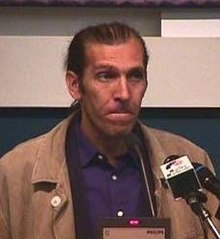
Antonio Russo
Credit: WikipediaOn June 3, 1960, an unknown mother left a newborn baby boy on the door steps of the only orphanage in the town of Francavilla al Mare (population 25,622 in the 2022 Census) in the province of Chieti in the region of Abruzzo. When the boy was six years old, he was adopted by a single woman named Beatrice Russo who named him Antonio. After graduating from the local high school, he went to Pisa to study veterinary medicine. He became a faculty member, but left in 1986 at the age of 26 to study philosophy at the Sapienza University in Rome. There he co-founded the magazine Philosophema, which launched his career as a journalist.
After earning his degree in philosophy in 1990 at the age of 30, Russo went to work as a reporter for Radical Radio. During the next nine years, he initially reported from Siberia in the Soviet Union, from Algeria during its bloody repression of dissent, and from Rwanda during the Hutu-Tutsi War. He was then assigned to cover the Second Congo War, Russian agitation in the eastern part of Ukraine, and political unrest in Colombia.
In early 1999, Russo was elected vice president of the Freelance International Press. Shortly thereafter, he was given the 20th International Journalism Prize by the island of Ischia off the coast of Naples. On May 28 of that year, he won the seventh “Clean Pens” Journalist Award given by the municipality of Sarteano in the province of Siena in the region of Tuscany. Also, on October 10 of the same year, he was bestowed with the third Ethics of Objectivity Prize by Mantua which is the capital of the province of the same name in the region of Lombardy.
In the year 2000, Russo was sent by Radical Radio to cover the Second Chechnya War in Russia. However, he was denied entry by the Russians, so he went to Tbilisi, the capital of neighboring Georgia, to interview refugees who had escaped from Chechnya and who claimed to have been victims of war crimes. He sent films and reports of his interviews to Radical Radio.
On the evening of October 15, he telephoned his adoptive mother and informed her that he had obtained a videotape documenting war crimes in Chechnya and that he planned to leave for Rome the next day. However, the next morning, his bruised and battered body was found on the edge of a country road which leads from the Vaziani Military Base where Russian forces were stationed. A search of his apartment by Georgian investigators revealed that it had been looted. His laptop computer, mobile telephone, video camera, and video tapes were missing. They believed but could not prove that agents of the Russian Federal Security Service murdered him. Antonio Russo was 40 years old. He never married.
In 2003, L’inquilino di via Nikoladze (The tenant on Nicholas Way) was released. It won the UNESCO Prize. In 2004, “Chechnya” was released about the time spent by Russo there. In May 2009, Daniel Biacchessi published his book entitled “Passionate Reporter” about Russo.
Sources: (all accessed April 23, 2024)
- en.wikipedia.org/wiki/Antonio_Russo
- en.wikipedia.org/wiki/Francavilla_al_Mare
- en.wikipedia.org/wiki/Sarteano
- en.wikipedia.org/wiki/Mantua
June 2024
